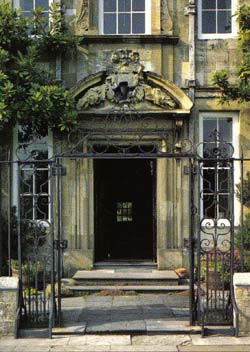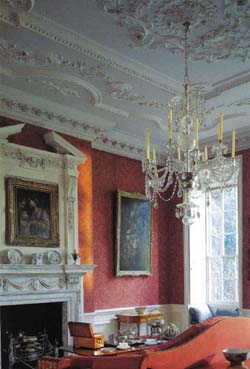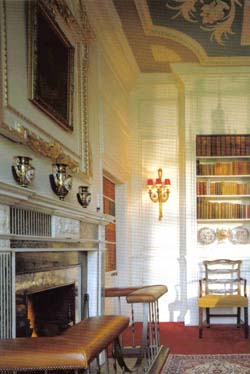Mompesson House
by Huw Francis
 Nobody famous owned this house, nor even
lived here, but a visit to Mompesson House will send you back in
time to the early 18th Century. Nobody famous owned this house, nor even
lived here, but a visit to Mompesson House will send you back in
time to the early 18th Century.
As you walk from Choristers Green, with the Cathedral spire
rising behind you, and pass through the original wrought iron
gates and enter the carved stone doorway, what little of the 21st
century that has invaded this far into old Salisbury will
disappear. Given the house's period authenticity, it is no wonder
that the 1996 Kate Winslett version of Sense and
Sensibility was filmed here. Film buffs will enjoy spotting
locations from the film.
Built in 1701 by Charles Mompesson, of the same Chilmark stone
used to build the cathedral, the house contains an impressive
collection of 18th century furniture. It has seen few major
changes since the improvements by Charles' brother-in-law,
Charles Longueville in the 1740's, when the main staircase,
drawing room fireplace and elaborately decorative plasterwork
were added.
It is not only the fact that the house is such an immaculate
example of its period that makes a visit so special, but the
attention to detail and the efforts of the guardians to bring
history to life. The dining room table laid for dinner, the
square piano in the drawing room and the special exhibitions put
on each year give unique insights into the life of the house.
This year there will be an exhibition of 18th-century drinking
glasses that will not only highlight the artefacts themselves,
but the social history and etiquette of drinking and the dramatic
change in glassware with the introduction of the Glass Tax in
1745. It is worth noting the designs on the glasses, with apples,
hops or barley often denoting the drink each glass was intended
to hold.
 Such is the wealth of history in the house
that each room has something to make a visitor stop for more than
a cursory glance. Even the ceilings demand attention and the
unwary will be so busy trying to take in everything on view they
are likely to end up tripping over another antique. Such is the wealth of history in the house
that each room has something to make a visitor stop for more than
a cursory glance. Even the ceilings demand attention and the
unwary will be so busy trying to take in everything on view they
are likely to end up tripping over another antique.
If accompanied by children, setting them the task of counting
every face in the plasterwork will keep them occupied, and they
will take great pleasure in pointing out birds, nymphs,
mythological kings and satyrs hidden among the vines. If they get
up to more than 40 faces they will be doing well and giving you
the chance to enjoy the rest of the house.
The ground floor Drawing Room was the place for formal larger
scale entertaining, and contrasts markedly to the more intimate
Little Drawing Room upstairs above the entrance hall. In the
upstairs drawing room, used by family and close friends and
overlooking the Close and the Cathedral, the ceiling plasterwork
is highlighted with an eagle, the traditional symbol of
welcome.
On either side of the Little Drawing Room are bedrooms and
opposite the entry doors to each bedroom is a false door in the
end wall, giving the impression there are more rooms beyond and
that the house is bigger than it is. The original Queen Anne
needlepoint chair and the fine brass and mother-of-pearl table
are of special interest here, as is the rare Stuart period stump
work (raised embroidery) on the walls.
The ladies' bedroom contains the bed where Kate Winslett cried so
copiously in Sense and Sensibility, but the Virginian
Walnut tallboy will be of equal interest to American visitors.
The Hepplewhite Rudd toilet table in the corner is also a rare
and intricate piece of furniture worth noting.
The bedrooms are decorated more simply than the rest of the
house, with no plasterwork on the ceilings. This economy is a
reminder that despite the grandeur of the house, it was built by
someone considered middle class at the time.
 In the
upstairs corridor are paintings by Barbara Townsend, a former
resident of the house, which add a personal touch to the
décor and give an insight into the pastimes and skills of
the English ladies who lived here. In the
upstairs corridor are paintings by Barbara Townsend, a former
resident of the house, which add a personal touch to the
décor and give an insight into the pastimes and skills of
the English ladies who lived here.
In the 1950s a bathroom was added in one of the rear bedrooms.
Fortunately the original panelling was left in place behind the
modern wall coverings, and now that the 20th century improvements
have been removed and the bare bones of the original room
exposed, visitors can see how the rest of the house was put
together and how it looked before restoration.
Tucked away in a downstairs corner, just before visitors step out
into the garden, is the Library. Styled and decorated by the last
resident of the house, who died in 1975, it is a cosy room
despite some clumsy 1950s restoration, and is the one place in
the house where visitors can sit upon the furniture and imagine
they are doing more than just passing through.
Outside in the garden is the last room of the house, the privy.
In the rear corner of the garden, behind the yew tree, an ornate
moulded stone doorway in the perimeter wall of the Close leads to
a panelled and cosy toilet, which originally emptied its waste
straight into the back lane.
The outside of Mompesson House also warrants some attention. The
front is neatly symmetrical, but the back, which fewer people
see, is more haphazard, as are the jumble of outbuildings inside
the carriage entrance. Original windows can be identified from
their smaller glass panes and larger leading lattice. Mompesson
House replaced an older building and the remains of the medieval
structure can be seen in the footings of the brick built wing not
open to the public.
A visit would not be complete without taking tea in the carriage
house and visitors can enjoy fresh cakes and a refreshing drink
in the shadow of a 200-year-old Magnolia Grandiflora and of
nearby medieval houses with their towering chimney stacks. To
complete the scene, the glorious flowers of an ancient laburnum,
enjoyed by many generations of Mompesson residents, adds summer
color to the garden.
More Information:
We regret that we no longer have the resources to maintain up-to-date links and/or hours and pricing details for the various sites and attractions listed on this website. For more information about the location(s) listed above, please use your favorite search engine or visit Wikipedia.
Huw Francis has worked as a freelance writer for ten years, covering primarily travel and international relocation topics. His work has been published in 16 countries and translated into French, Spanish and Korean. He has lived in England, Hong Kong, Turkey and France, and currently resides in Wales.
Article © 2007 Huw Francis
Photos courtesy of National Trust
| 